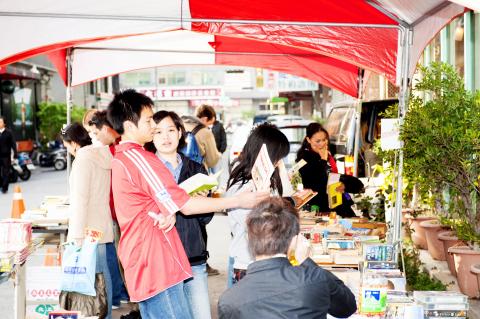What started off seven years ago as a small book sale to raise money for charity has blossomed into a mini-festival with bands, a children’s show, and a great selection of donated books that start at NT$50, though organizers are encouraging larger donations.
The proceeds from tomorrow’s event will go to the Childhood Burn Foundation of the ROC (中華民國兒童燙傷基金會).
The music, provided by a nine-band lineup that includes Dirty Skies, The Ever So Friendlies, and Three Day Bender, begins at 1pm. From 4pm to 7pm there will be entertainment for the kids by Taichung Improv and a ventriloquist.

Photo COURTESY OF Henry Westheim
A raffle starts at dusk and continues between bands with prizes ranging from scuba dives and gym memberships to chiropractor sessions, sax lessons and a mountain bike, as well as other merchandise from the event’s sponsors.
■ Whose Travel Seventh Annual Charity Book Exchange at Frog 1, 106, Huamei W St Sec 1, Greater Taichung (台中市華美西街一段106號)
■ Tomorrow from noon to 11:30pm, with bands from 1pm, and children’s entertainment from 4pm to 7pm
■ Admission is free. On the Net: www.whosetravel.com/special_pages/book_exchange_2011_call_for_books.htm

May 11 to May 18 The original Taichung Railway Station was long thought to have been completely razed. Opening on May 15, 1905, the one-story wooden structure soon outgrew its purpose and was replaced in 1917 by a grandiose, Western-style station. During construction on the third-generation station in 2017, workers discovered the service pit for the original station’s locomotive depot. A year later, a small wooden building on site was determined by historians to be the first stationmaster’s office, built around 1908. With these findings, the Taichung Railway Station Cultural Park now boasts that it has

Wooden houses wedged between concrete, crumbling brick facades with roofs gaping to the sky, and tiled art deco buildings down narrow alleyways: Taichung Central District’s (中區) aging architecture reveals both the allure and reality of the old downtown. From Indigenous settlement to capital under Qing Dynasty rule through to Japanese colonization, Taichung’s Central District holds a long and layered history. The bygone beauty of its streets once earned it the nickname “Little Kyoto.” Since the late eighties, however, the shifting of economic and government centers westward signaled a gradual decline in the area’s evolving fortunes. With the regeneration of the once

In February of this year the Taipei Times reported on the visit of Lienchiang County Commissioner Wang Chung-ming (王忠銘) of the Chinese Nationalist Party (KMT) and a delegation to a lantern festival in Fuzhou’s Mawei District in Fujian Province. “Today, Mawei and Matsu jointly marked the lantern festival,” Wang was quoted as saying, adding that both sides “being of one people,” is a cause for joy. Wang was passing around a common claim of officials of the People’s Republic of China (PRC) and the PRC’s allies and supporters in Taiwan — KMT and the Taiwan People’s Party — and elsewhere: Taiwan and

Even by the standards of Ukraine’s International Legion, which comprises volunteers from over 55 countries, Han has an unusual backstory. Born in Taichung, he grew up in Costa Rica — then one of Taiwan’s diplomatic allies — where a relative worked for the embassy. After attending an American international high school in San Jose, Costa Rica’s capital, Han — who prefers to use only his given name for OPSEC (operations security) reasons — moved to the US in his teens. He attended Penn State University before returning to Taiwan to work in the semiconductor industry in Kaohsiung, where he